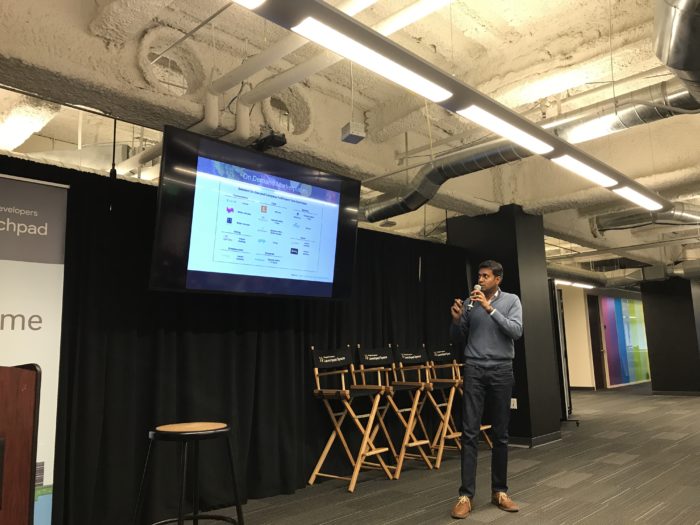Image via CrunchBase With Demand Media filing for their long-expected IPO last week, the discussion…
Entrepreneurship, Marketplaces / Social / Collaboration / Network Effects
This is the first in a series of posts summarizing our speakers’ insights from the Data-driven Marketplace Meetup on May 16. Today, we just need to pick up a phone to order groceries or a fully cooked meal, or hire someone to do our laundry or walk the dog. The rise of on-demand service apps […]
Image via CrunchBase With Demand Media filing for their long-expected IPO last week, the discussion…
Nearly two years ago, we published our first ebook, A Guide to Marketplaces. Towards the…
This is the first in a series of posts summarizing our speakers’ insights from the Data-driven Marketplace Meetup on May 16.
Today, we just need to pick up a phone to order groceries or a fully cooked meal, or hire someone to do our laundry or walk the dog. The rise of on-demand service apps has been spurred on by two things. First, everyone has a smartphone that can send location data and two, there are independent workers who prefer the flexibility of the gig economy to a traditional 9 to 5 schedule.
We all see how on-demand apps are making our daily lives easier and shaking up entire industries in the process. What many may not appreciate are the underlying logistics that enable these new kinds of marketplaces to work at scale. That’s why we were so excited to have Bala Ganapathy, product lead at Instacart, speak at our data-driven marketplace meetup last month.

At its core, Instacart is an on-demand logistics platform. They need to move goods (groceries) from Point A (the grocery store) to Point B (your front door) as efficiently as possible. We may think about Instacart as groceries, but Bala explained that their real product is the ecosystem: they have enough shoppers on the road to meet the demands of every customer and make every delivery on time.
So, what needs to happen behind the scenes at Instacart? What are the logistics involved? As Bala explained, there are two key components:
Bala shared some key insights as to how Instacart works to achieve these two goals. He referred to these as the lubricant that helps a complex engine run smoothly by creating a virtuous cycle (which we all know is the target for any marketplace company).
1) Leverage demand density
As demand density increases, the incremental costs (fulfillment costs) go down. Instacart measures density in two dimensions: Space and Time. If you’re building an on-demand business, think about how you can target demand creation in both of these dimensions. Then equalize demand across time and space by subsidizing supply until there is enough organic traction.
2) Create demand shock absorbers
Bala shared that no matter what kind of algorithms might be powering your logistics systems, there will always be some variation in demand and supply and you need to have the right strategies to restore equilibrium.
Pricing can be a great lever. For example, Instacart ran an experiment in San Francisco where they gave customers a discount in exchange for a larger delivery window (5 hours instead of 1-2 hours). They could then use the more flexible deliveries as fillers for incremental efficiency. Likewise, Instacart can also offer a discount (or faster delivery time) to encourage customers to place orders during those times when stores and roads are less crowded.
3) Create supply shock absorbers
Bala also shared some of the techniques that can be used to help the supply curve. Instacart knows that there are certain times when there might be more customers than shoppers – for example, on Monday mornings, office managers might be looking to restock but there are fewer shoppers who are jumping in to work so early in the week.
In this case, one strategy is to pay shoppers more on Monday compared to Wednesday to ensure that there’s always capacity to fulfill orders (think surge pricing). Another strategy is to ensure guaranteed income (base pay) to shoppers to help alleviate the risk of working during a non-desirable time and not getting paid.
Of course, there are other strategies and product choices that Instacart and other on-demand marketplaces can adopt to optimize their logistics system – but as you can see, Bala provided some very tangible advice and insight in a brief presentation. Much thanks to Bala for sharing his knowledge and experiences with all of us, and stay tuned for more summaries from our other speakers over the coming weeks.
Portfolio
It’s hard to believe we’re already three quarters into the year. At V1, we’re all about finishing strong, and Q3 gave us plenty of reasons to be excited about what’s ahead. As always, we’ve rounded up a quick snapshot of the action across our portfolio from the past quarter: Funding announcements We welcomed TRIC Robotics […]
The V1 family kicked off the new year with fresh energy and no shortage of…
Fall is in the air and we are heading into the last quarter of 2023.…